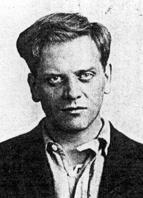
Information to change the world | |
Find Topics, Titles, Names related to your query |

Information to change the world | |
Find Topics, Titles, Names related to your query |
|
|
Ralph Chaplin
|
|||||||||||
| Ralph Hosea Chaplin | |
|---|---|
 |
|
| Born | 1887 Ames, Kansas |
| Died | 1961 |
| Occupation | Labor activist, songwriter, illustrator |
Ralph Hosea Chaplin (1887–1961) was an American writer, artist and labor activist. At the age of seven, he saw a worker shot dead during the Pullman strike in Chicago, Illinois. He had moved with his family from Ames, Kansas to Chicago in 1893. During a time in Mexico he was influenced by hearing of the execution squads established by Porfirio Diaz, and became a supporter of Emiliano Zapata. On his return, he began work in various union positions, most of which were poorly paid. Some of Chaplin's early artwork was done for the International Socialist Review and other Charles H. Kerr publications.
For two years Chaplin worked in the strike committee with Mother Jones for the bloody Kanawha County, West Virginia strike of coal miners in 1912-13. These influences led him to write a number of labor oriented poems, one of which became the words for the oft-sung union anthem, "Solidarity Forever".
Chaplin then became active in the Industrial Workers of the World (the I.W.W., or "Wobblies") and became editor of its eastern U.S. publication Solidarity. In 1917 Chaplin and some 100 other Wobblies were rounded up, convicted, and jailed under the Espionage Act for conspiring to hinder the draft and encourage desertion. He wrote Bars And Shadows: The Prison Poems while serving four years of a 20-year sentence.
Although he continued to work for labor rights after his release from prison, Chaplin was very disillusioned by the aftermath of the Russian Revolution. However, he was also not pleased by the course of New Deal liberalism. Chaplin maintained his involvement with the I.W.W., serving in Chicago as editor of its newspaper, the Industrial Worker, from 1932 to 1936. He became active in the cause of preventing Communist infiltration in American unions.
Eventually Chaplin settled in Tacoma, Washington, where he edited the local labor publication. From 1949 until his death he was curator of manuscripts for the Washington State Historical Society.
He is credited with designing the now widely used anarcho-syndicalist image, the black cat. As its stance suggests, the cat is meant to suggest wildcat strikes and radical unionism.
Related topics in the Connexions Subject Index
Alternatives –
Left History –
Libraries & Archives –
Social Change –
This article is based on one or more articles in Wikipedia, with modifications and additional content contributed by
Connexions editors. This article, and any information from Wikipedia, is covered by a
Creative Commons Attribution-Sharealike 3.0 Unported License (CC-BY-SA) and the
GNU Free Documentation
License (GFDL).
We welcome your help in improving and expanding the content of Connexipedia articles, and in correcting errors. Connexipedia is not a wiki: please contact Connexions by email if you wish to contribute. We are also looking for contributors interested in writing articles on topics, persons, events and organizations related to social justice and the history of social change movements.
For more information contact Connexions



